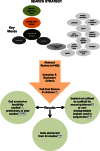Biomaterial-based interventions for neuronal regeneration and functional recovery in rodent model of spinal cord injury: a systematic review
- PMID: 23809587
- PMCID: PMC3654443
- DOI: 10.1179/2045772313Y.0000000095
Biomaterial-based interventions for neuronal regeneration and functional recovery in rodent model of spinal cord injury: a systematic review
Abstract
Context: There is considerable interest in translating laboratory advances in neuronal regeneration following spinal cord injury (SCI). A multimodality approach has been advocated for successful functional neuronal regeneration. With this goal in mind several biomaterials have been employed as neuronal bridges either to support cellular transplants, to release neurotrophic factors, or to do both. A systematic review of this literature is lacking. Such a review may provide insight to strategies with a high potential for further investigation and potential clinical application.
Objective: To systematically review the design strategies and outcomes after biomaterial-based multimodal interventions for neuronal regeneration in rodent SCI model. To analyse functional outcomes after implantation of biomaterial-based multimodal interventions and to identify predictors of functional outcomes.
Methods: A broad PubMed, CINHAL, and a manual search of relevant literature databases yielded data from 24 publications; 14 of these articles included functional outcome information. Studies reporting behavioral data in rat model of SCI and employing biodegradable polymer-based multimodal intervention were included. For behavioral recovery, studies using severe injury models (transection or severe clip compression (>16.9 g) or contusion (50 g/cm)) were categorized separately from those investigating partial injury models (hemisection or moderate-to-severe clip compression or contusion).
Results: The cumulative mean improvements in Basso, Beattie, and Bresnahan scores after biomaterial-based interventions are 5.93 (95% CI = 2.41 - 9.45) and 4.44 (95% CI = 2.65 - 6.24) for transection and hemisection models, respectively. Factors associated with improved outcomes include the type of polymer used and a follow-up period greater than 6 weeks.
Conclusion: The functional improvement after implantation of biopolymer-based multimodal implants is modest. The relationship with neuronal regeneration and functional outcome, the effects of inflammation at the site of injury, the prolonged survival of supporting cells, the differentiation of stem cells, the effective delivery of neurotrophic factors, and longer follow-up periods are all topics for future elucidation. Future investigations should strive to further define specific factors associated with improved functional outcomes in clinically relevant models.
Figures



References
-
- Di Giovanni S. Regeneration following spinal cord injury, from experimental models to humans: where are we? Expert Opin Ther Targets 2006;10(3):363–76 Available from: Epub 2006 May 19 - PubMed
-
- Assina R, Sankar T, Theodore N, Javedan SP, Gibson AR, Horn KM, et al. Activated autologous macrophage implantation in a large-animal model of spinal cord injury. Neurosurg Focus 2008;25(5):pE3. Available from: Epub 2008 Nov 5 - PubMed
-
- Bouhy D, Malgrange B, Multon S, Poirrier AL, Scholtes F, Schoenen J, et al. Delayed GM-CSF treatment stimulates axonal regeneration and functional recovery in paraplegic rats via an increased BDNF expression by endogenous macrophages. FASEB J 2006;20(8):1239–41 Epub 2006 Apr 26 - PubMed
Publication types
MeSH terms
Substances
LinkOut - more resources
Full Text Sources
Other Literature Sources
Medical
